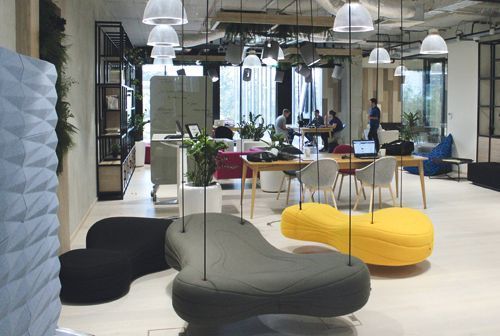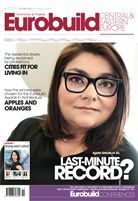The height of fashion or off the peg?
Architecture
Office design quite often depends on the budget and not on the trends. Nevertheless, as many office design studios claim, there exist more and less popular trends. “The general trend is to change the working culture, so soft seatings, bar stools and all kinds of high tables are becoming popular. Companies are still into the idea of shared desking, and different types of work places are being created,” says Danuta Barańska, the creative director in Tétris. According to Zbigniew Kostrzewa, who heads the In Design studio, at the moment there are two clear trends. “The first of which I wouldn’t call an interior design trend, but rather the art of set designing or the art of decoration, which can be seen in those offices created after the opening of Google’s headquarters. They are supposed to be cool, but don’t actually improve the working conditions. The second trend is about timeless form, which is what real interior design is about,” explains Zbigniew Kostrzewa. However, these two trends consist of different sub-trends.
Individualism pays off
Companies want their office design to be so individual that once you enter the place, you immediately recognise whose office you are visiting. “Making references to the company’s business isn’t a trend, it’s a fundamental,” says Zbigniew Kostrzewa. “One of our projects for a biotechnology company was based on a plant motif. Certainly, no one can directly refer to the activities of some businesses such as insurance companies, as it would be really hard to depict accidents. In such cases, a motif that reflects a company’s values has to be chosen,” he explains. “As far as office furniture is concerned, modular is what’s in demand, because of its so adaptable and can meet different needs for different employees,” adds Magdalena Sąsiadek. “Currently, we’re concentrating totally on individual solutions. With furnishings, the adaptability and portability of modular furniture gives us a lot of freedom in design, without forcing us to invest more in the refurbishment,” says Piotr Fenrych, a project manager at Xplan. “Clients most often order high tables and furniture for their so-called idea labs and creative rooms,” says Katarzyna Jasińska from Bene. More and more people are ordering custom-made furniture, especially for the CEO’s offices, although such spaces are becoming ever less popular. Companies also wish to have table football, game consoles, or even a gym in their offices, regardless of whether there is a fitness club in the office building or not. Sometimes companies decide to have their own canteens, massage rooms, movie screening rooms. Journalists might perhaps feel particularly flattered by the explanation for such facilities... “Sometimes clients find their inspiration in all accessible sources, such as magazines or the internet,” says one representative of Spaceplan.
Chasing logos
A company’s logo is very often one of the leading motifs in interior design. “This trend, however, is now in decline. Unlike a few years ago, companies these days don’t want to flash their logo so this trend is now petering out,” claims Danuta Barańska. Instead, what the creative director of Tétris, now says is in now is referring to the client’s brands and products , and such visual references are often displayed in common areas and conference rooms, such as in the headquarters of Wyborowa Pernod Ricars or the offices of Stanley Black & Decker. Companies like to use the colours of their logos. For example, the reception area might be navy-blue because of such squares used in the logo or there could be a red line running through an entire office because of the dominant colour in the company’s symbol. Fashionable designs are often inspired by the culture and treasures of Poland or the city where the office is located, even if it is a multinational company. Another source of inspiration may be plants and animals.
Mad race
“Once a Barrisol stretch ceiling or branded furniture was enough. Now companies know if they want strong colours with graffiti on the walls and that offices look more natural with greenery and wooden features,” says Olga Magdziak from Spaceplan. Firms that employ millennials, particularly IT companies, go for bolder designs, whereas law firms request more subdued colours in their offices. “It’s been like this for a long time. Before in the 80s and 90s, there weren’t so many differences between offices,” explains Danuta Barańska. In Google-style offices, it’s very trendy to introduce surprising features such as a power-generating pedal bike, hammocks, swings, inflatable balls to sit on. “The more unusual, the better,” says Zbigniew Komosa, the business development manager at Artservis. In some offices, for instance, you might see a tree house, a desk with a treadmill where you can walk and work at the same time, a cable car (as in the Brain Embassy) a car converted into a phone booth (Echo Investment) or half a car hung as a wall decoration. The CEO’s office might be decorated with football paraphernalia, or there could be a small art gallery for an art-loving lawyer.
Frankenstein of the Pinterest Era
”Google-style offices are not about interior design, but once a trend-setter like Google presents an idea, it catches on instantly. People take it as gospel and copy it mindlessly. If a pasta producer had been the first to create such an office, everyone would have probably found it tacky,” claims Zbigniew Kostrzewa. In his opinion, a Google-style interior is very tiring. “It’s great to take a look at the photos or have a quick visit, but if you were to work there all day long, all that ’cool’ stuff would become a bit boring or even tiresome. People get over-stimulated so it’s hard to concentrate in a space like that,” he claims. According to Katarzyna Jasińska of Bene, research shows that employees don’t feel comfortable in Google-style offices and, what’s more important, these offices don’t meet the staff’s actual needs. “Space for interaction’s quite an important part of an office but it has to be elastic, functional and open to everybody and it shouldn’t look like a playground,” she claims. “It’s something like an Frankenstein office made up of mismatching parts, which barely functions and seems a little crippled,” says Zbigniew Kostrzewa and adds that it is the Pinterest era. “A designer shows several pictures from Pinterest, and puts everything that the client wants into the project. Here a bit of this, there something else. Nothing matches. Sometimes I wonder with my colleagues, if an interior designer is needed at all in such a process,” he states.
Feels like home
It turns out that these days it is the technology, the light and the air quality that matter. And there is no need for drastic measures such as moving your office or having a complete renovation. “Non-standard lighting such as hanging lamps that are not built-in in the ceiling is being introduced. The lighting is diverse, it’s no longer identical or pre-fitted,” explains Sylwia Prokop. Making offices more homelike is certainly a growing trend, with carpets, Persian rugs, and plants in colourful pots. “There are now offices where employees even wear slippers,” adds the creative director of Tétris. Companies are putting in armchairs to remind you of home, and using warm colour schemes and fabrics. “Offices not only have relaxation zones, but also nap zones,” admits Zbigniew Komosa from Artservis.
Keep calm and design on
“Dramatic and vivid colours in offices are out. Depending on the kind of business they’re in, our clients are happy to accept green walls, decorative plasterwork, wallpaper, modern lighting, ceiling islands or different furniture adapted for different types of work,” says Piotr Fenrych, a design specialist in Xplan. Others in the market concur and this can be seen in the new offices of CCC. “Simplicity, attention to detail and natural materials rule. Such interiors are timeless, because they have their own spirit. Flashy spaces, packed with numerous details in various styles are passé. ‘Less is more’ as Mies van der Rohe claimed,” says Paweł Śnieżek, an interior designer in Finishome. A simple interior with only one design feature, such as, an interesting, or expensive, modern lamp, or holographic wallpaper is an increasingly popular trend.
“It was only recently that reception areas were stuffed full of designer items; everything was overdesigned including the ceilings, the shape of the reception desks, the lighting and the colour schemes. Now companies prefer to invest in a real eye-catcher, which adds to the elegance of the interior. Startling interiors are in decline,” claims Olga Magdziak. Functionality is back. Glazed walls are increasingly used to divide up rooms without optically diminishing the space. “The accumulation of stuff, colours and stimuli soon turns out to be rather lacking in functionality, and even tiring in the long run,” says Katarzyna Jasińska and adds that now it’s very trendy to place multi-purpose pastel furniture in a calm interior with glass walls just as it is in the new CCC office.
Silence is key
Soundproofing is another strong trend. The hottest trends are open ceilings, island ceilings, painted installations. Smooth suspended ceilings are now out. These trends make soundproofing an even a greater challenge. One trend is the use of individual, interestingly designed, and often very decorative acoustic baffles. Such panels are not only placed underneath ceilings, but also over doorways. They might depict a blue sky with clouds and be placed above the desks. “Sometimes, at the price approval stage, we present good and interesting soundproofing ideas, which are rejected by clients because of the price. However, they often come back to these ideas at a later stage,” says Olga Magdziak. It seems no one makes huge working spaces anymore. There are Sofas between the different sections of an office or even single room dividers installed. Informal space is usually provided between such dividers. “Spaces without divisions simply don’t work. We build work space divided by sections, such as those the in Mbank’s office,” says Zbigniew Kostrzewa of In Design.
From belly to brain
Nowadays canteens are becoming a place to socialise rather than just a place to eat meals. “If possible, canteens should be designed as larger rooms. Some of them have football tables and I’ve even seen designs with swings,” says Magdalena Sąsiadek. Some canteens have glass walls and link two sections of an open space office. Some offices have canteens with a fully equipped kitchen, including an oven and electric hobs, which allow employees to cook up their lunch from scratch. However, this fashion has a counter-trend. Some companies are moving away from installing ovens or even microwaves as they prefer for their employees to use catering services.
The factory of the future
The industrial style became fashionable around five years ago and is never going out of fashion. The style is changing with new features being added. More greenery and natural materials are being used. “Interiors with industrial, loft designs often emphasise a practical approach to work,” says Łukasz Koziana, the founder of the Iliard studio. The so-called offices of the future are another common trend. “They are fully computerised and utilise multimedia as well as every conceivable technology,” says Paweł Śnieżek. “In ten years’ time there will technology will be different and offices will have to adapt as new ways of working will probably appear. New trends will follow the arrival of new technology. Systems that improve our work such as machine learning, AR or VR are appearing now. If ways of communicating change, the offices of the future will look completely different and it’s hard to predict what they actually will be like,” says Zbigniew Kostrzewa.





















































